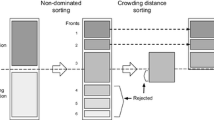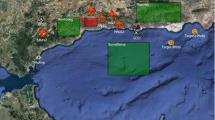Abstract
Due to the rapid development of the UAVs capabilities, these are being incorporated into many fields to perform increasingly complex tasks. Some of these tasks are becoming very important because they involve a high risk to the vehicle driver, such as detecting forest fires or rescue tasks, while using UAVs avoids risking human lives. Recent researches on artificial intelligence techniques applied to these systems provide a new degree of high-level autonomy of them. Mission planning for teams of UAVs can be defined as the planning process of locations to visit (waypoints) and the vehicle actions to do (loading/dropping a load, taking videos/pictures, acquiring information), typically over a time period. Currently, UAVs are controlled remotely by human operators from ground control stations, or use rudimentary systems. This paper presents a new Genetic Algorithm for solving Mission Planning Problems (GAMPP) using a cooperative team of UAVs. The fitness function has been designed combining several measures to look for optimal solutions minimizing the fuel consumption and the mission time (or makespan). The algorithm has been experimentally tested through several missions where its complexity is incrementally modified to measure the scalability of the problem. Experimental results show that the new algorithm is able to obtain good solutions improving the runtime of a previous approach based on CSPs.
Access this chapter
Tax calculation will be finalised at checkout
Purchases are for personal use only
Similar content being viewed by others
References
Bello-Orgaz, G., Camacho. D.: Evolutionary clustering algorithm for community detection using graph-based information. In: IEEE Congress on Evolutionary Computation (CEC), 2014, IEEE, pp. 930–937 (2014)
Bin, X., Min, W., Yanming, L., Yu, F.: Improved genetic algorithm research for route optimization of logistic distribution. In: Proceedings of the 2010 International Conference on Computational and Information Sciences, ICCIS ’10, IEEE Computer Society, pp. 1087–1090, Washington (2010)
Doherty, P., Kvarnström, J., Heintz, F.: A temporal logic-based planning and execution monitoring framework for unmanned aircraft systems. Auton. Agents Multi-Agent Syst. 19(3), 332–377 (2009)
Geng, L., Zhang, Y.F., Wang, J.J., Fuh, J.Y.H., Teo, S.H.: Cooperative task planning for multiple autonomous uavs with graph representation and genetic algorithm. In: 10th IEEE International Conference on Control and Automation (ICCA), IEEE, pp. 394–399 (2013)
Kendoul, F.: Survey of advances in guidance, navigation, and control of unmanned rotorcraft systems. J. Field Robot. 29(2), 315–378 (2012)
Menendez, H.D., Barrero, D.F., Camacho, D.: A co-evolutionary multi-objective approach for a K-adaptive graph-based clustering algorithm. In: IEEE Congress on Evolutionary Computation (CEC), IEEE, pp. 2724–2731 (2014)
Merino, L., Caballero, F., Martínez-de Dios, J.R., Ferruz, J., Ollero, A.: A cooperative perception system for multiple uavs: Application to automatic detection of forest fires. J. Field Robot. 23(3–4), 165–184 (2006)
Pereira, E., Bencatel, R., Correia, J., Félix, L., Gonçalves, G., Morgado, J., Sousa, J.: Unmanned air vehicles for coastal and environmental research. J. Coast. Res. pp. 1557–1561 (2009)
Ramírez-Atencia, C., Bello-Orgaz, G., R-Moreno, M.D., Camacho, D.: Branching to find feasible solutions in unmanned air vehicle mission planning. Intelligent Data Engineering and Automated Learning–IDEAL 2014, pp. 286–294. Springer, Switzerland (2014)
Soliday, S.W., et al.: A genetic algorithm model for mission planning and dynamic resource allocation of airborne sensors. In Proceedings of the1999 IRIS National Symposium on Sensor and Data Fusion. Citeseer (1999)
Wu, J., Zhou, G.: High-resolution planimetric mapping from uav video for quick-response to natural disaster. In IEEE International Conference on Geoscience and Remote Sensing Symposium, IGARSS, IEEE, pp. 3333–3336 (2006)
Acknowledgments
This work is supported by Comunidad Autónoma de Madrid under project CIBERDINE S2013/ICE-3095, Spanish Ministry of Science and Education under Project Code TIN2014-56494-C4-4-P and Savier Project (Airbus Defence & Space, FUAM-076915). The authors would like to acknowledge the support obtained from Airbus Defence & Space, specially from Savier Open Innovation project members: José Insenser, César Castro and Gemma Blasco.
Author information
Authors and Affiliations
Corresponding author
Editor information
Editors and Affiliations
Rights and permissions
Copyright information
© 2016 Springer International Publishing Switzerland
About this paper
Cite this paper
Bello-Orgaz, G., Ramirez-Atencia, C., Fradera-Gil, J., Camacho, D. (2016). GAMPP: Genetic Algorithm for UAV Mission Planning Problems. In: Novais, P., Camacho, D., Analide, C., El Fallah Seghrouchni, A., Badica, C. (eds) Intelligent Distributed Computing IX. Studies in Computational Intelligence, vol 616. Springer, Cham. https://doi.org/10.1007/978-3-319-25017-5_16
Download citation
DOI: https://doi.org/10.1007/978-3-319-25017-5_16
Published:
Publisher Name: Springer, Cham
Print ISBN: 978-3-319-25015-1
Online ISBN: 978-3-319-25017-5
eBook Packages: EngineeringEngineering (R0)




